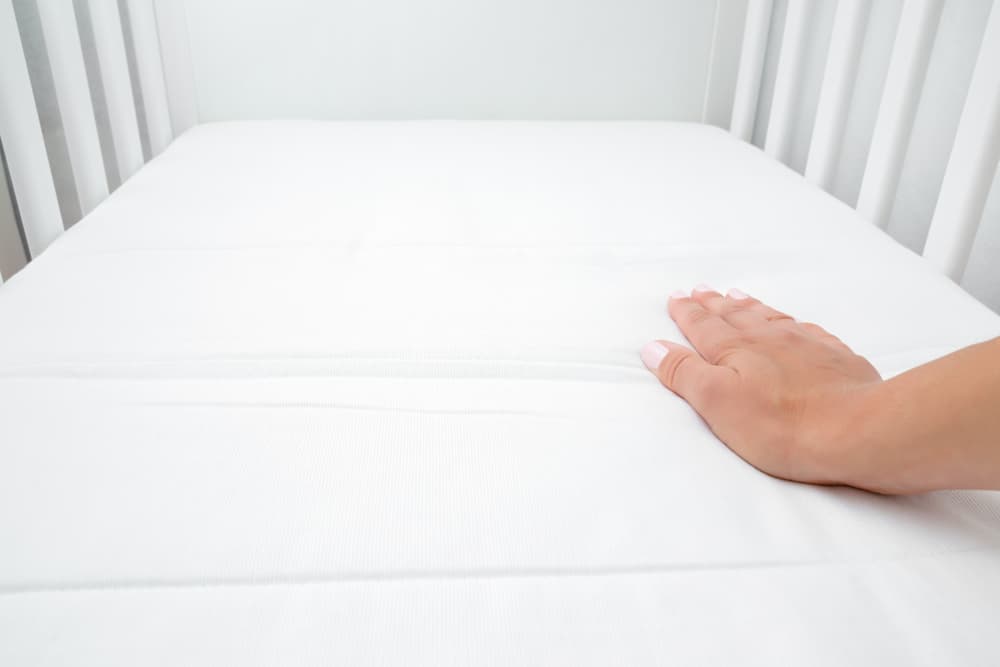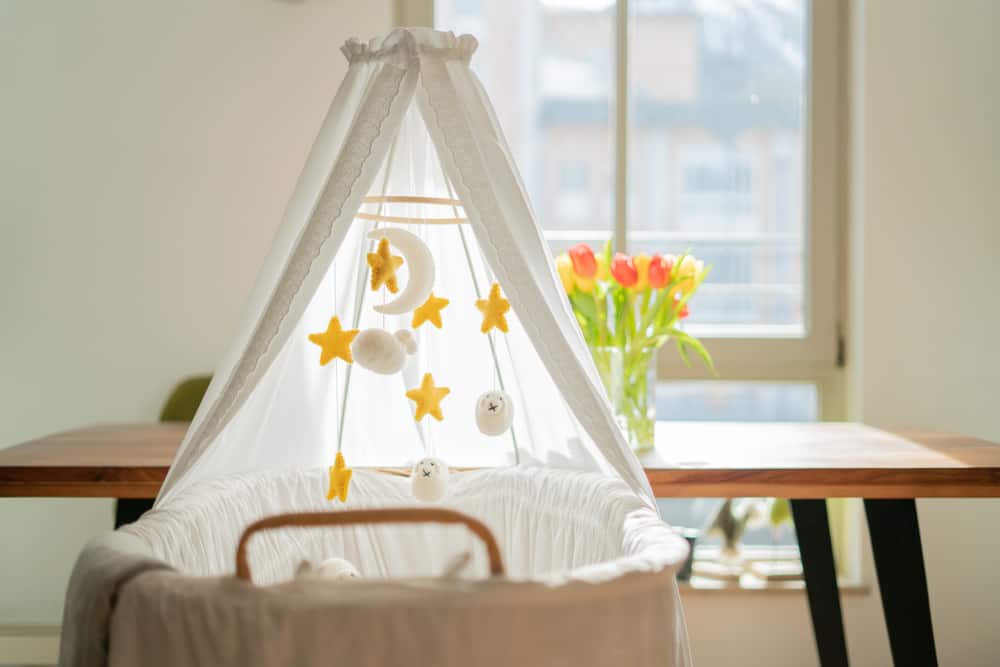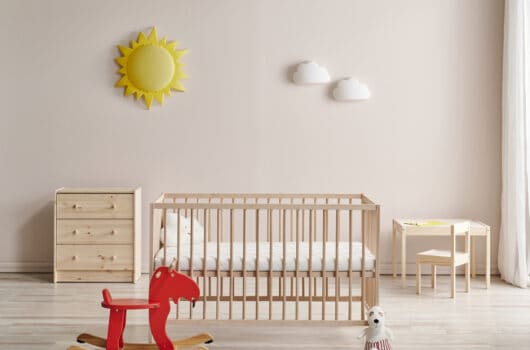Even though babies are small, they certainly need a lot of stuff! New parents spend a lot of money on buying baby equipment and one of the biggest purchases that you’re likely to make is sure to be the crib.
Choosing a crib is a major consideration. After all, your little one spends a lot of time in it – potentially a few years until they make the transition to a bed. So, that means you need to get the choice right in terms of color, style, size and, above all else, safety.
Making a safe place for your little one to sleep involves a lot of preparation and thought, and learning about crib safety standards is the starting point. If you choose a crib that doesn’t come up to the current standard you could be putting your infant at risk of suffocation, strangulation or entrapment – something that no parent wants to expose their child to.
The good news is that the CPSC (Consumer Product Safety Commission) has put in place rigorous standards that ensure all cribs sold today are safe, durable and strong for your little one to sleep in and that makes it easier and less stressful to shop for this major purchase.
If you’re planning to purchase a second-hand crib, though, it can be harder to know what you’re looking for. Not every pre-used product will match the latest crib safety standards, so you need to know about what makes a crib safe for your newborn to use.
So, read on to discover more about crib safety and how you can ensure your little one’s sleeping space will keep them safe from any potential harm.
- Is My Crib Safe?
- Checking Measurements
- No Rough Edges
- Secure Hardware
- Non-Toxic Paint
- Mattress Fit
- Avoiding Bedding and Soft Toys
- Avoiding Drop-Sides and Footboard and Headboard Cutouts
- Is a Second Hand Crib Safe to Use?
- What About Safety Standards for Bassinets?
- Following the Latest Crib Safety Standards Is Paramount
Is My Crib Safe?
If you’ve already purchased a crib for your little one, you may be wondering whether you’ve made the right choice and whether the item you’ve purchased is in line with current crib safety standards. Fortunately, if you’ve only just bought a brand-new product you can rest assured that it’ll be perfectly safe to use. Every crib made since 2011 must meet the CPSC’s rigorous safety standards so as long as you purchased from a reliable and trustworthy supplier, you can be confident that your little one won’t come to any harm.
Nevertheless, if you have any concerns, you can check through the safety crib checklist below that will help you to determine whether the crib you intend to use for your baby meets current standards.
Checking Measurements
- The slats or bars of your crib shouldn’t be over 2 3/8” in width (around the same width as a standard soda can). Also, no bars should be missing or broken.
- The crib rail’s top should be a minimum of 26” from the mattress’ surface.
- The crib’s corner posts must be flush with the headboard’s top or much higher (over 16” higher). If the posts are between these two heights your baby’s clothes could get caught if they try to climb out.
No Rough Edges
- The corner posts must be flush with the crib’s end panels.
- If there are any knobs or fancy finials they must be sawn off and the edges sanded down so they’re smooth.
Secure Hardware
- All screws and bolts must be secured firmly with no rough areas, sharp edges or spots which may hurt your baby.
- The wood of the crib must have no splits or cracks.
- The whole crib must be sturdy and have tight joints.
- No original parts should be substituted with generic parts from a hardware store. All replaced components should come direct from the manufacturer.
Non-Toxic Paint
When you’re choosing a paint for your infant’s crib, make sure that the color isn’t the only consideration. Cribs that were made before 1978 could have lead in the paint finish used and this can be dangerous for your baby’s health.
Should you have reason to believe your crib has been painted with a lead-based paint, strip it outside the house using EPA (Environmental Protection Agency) best practices. Once all the paint is removed, repaint it using a lead-free, high-quality enamel that is labeled as being safe for use in nurseries. You should only use paints that are non-toxic and that contain no VOCs (volatile organic compounds).
If the crib has any paint that is cracked or peeling it should be refinished (even if the paint is lead-free).
Mattress Fit
You must ensure the crib’s mattress fits snugly against the crib’s inside. The 2-finger test is the best way to ensure the crib is safe. If it’s possible to fit over 2 fingers between the crib and the mattress, then the mattress is a poor fit. Although it may be inconvenient, if it’s difficult for you to put sheets on the mattress, the better it is for your little one.
If you’d rather use measurements than simply fitting your fingers between the mattress and crib, you should know that a standard full-size mattress for a crib must measure a minimum of 27 ¼” x 51 ¼”. It should also be a maximum of 6” in thickness.
If you’ve purchased a brand-new mattress, always take the plastic wrapping off and discard it immediately.

Also, ensure the mattress you’ve chosen is firm. Soft mattresses may increase the likelihood of SIDS (sudden infant death syndrome). Rather than relying on the mattress label to tell you its firmless level, you should test it with your own hands. Press down on the mattress hard and you should find the mattress stays firm, springing right back.
Avoiding Bedding and Soft Toys
Although it’s tempting to load up your baby’s crib with cute bedding like comforters and bumpers, or giving them cuddly toys to sleep with, it’s important to be aware that you should never do this. This is because they’ve been found to be a serious suffocation risk.
It has been advised by the AAP (American Academy of Pediatrics) that no bumper pads be used in cribs since they’ve been associated with an increase incidence of SIDS. Soft crib bedding must also be avoided until your little one reaches at least 12 months of age and preferably 18 months. Babies aged between 12 and 18 months can have a small cuddly toy or thin blanket to use as a transitional object if they’re suffering from sleep issues – this is considered to be safe.
Bumper pads should be avoided completely, even after your baby has turned one and the chance of sudden infant death syndrome has dramatically dropped. Although they probably won’t represent a suffocation risk once your little one has become a toddler, it’s possible curious infants could try climbing on one to try to get out of their crib and this raising the possibility of them getting injured.
Avoiding Drop-Sides and Footboard and Headboard Cutouts
Avoiding cribs that have decorative cutouts on the footboard or headboard is important, as is steering clear of any crib that has a drop side. The CPSC outlawed both of these things in 2011 due to safety risks that they present.
Is a Second Hand Crib Safe to Use?
It can be expensive to invest in a brand-new crib so it’s no wonder that so many new parents want to save money by choosing a crib that is second-hand. Also, some moms and dads want to use a crib which has been passed through generations of the family for sentimental reasons. Nevertheless, it’s important to be aware that second-hand cribs may not always be safe, particularly if they’re over a decade old.
In 2011, crib safety was made top priority by the CPSC when strict standards were set for retailers and manufacturers alike. Those requirements included strong crib slats and mattress supports, more durable hardware and safety testing that is considerably more rigorous. Also, the organization put a stop to the selling and manufacturing of drop-side cribs which have been found to be very dangerous.
Cribs which are older are far less likely to be able to meet those standards, and this makes them more hazardous. They may have:
- Slats which are excessively spaced apart
- Lead paint
- Splintered or cracked wood
- Corner posts that are unsafe
- Cutout decorations in the footboard or headboard
- Drop-sides
If you’re considering buying a used crib, you should take extra time to check it over for potential flaws that could be hazardous for your baby. Even when second-hand cribs look fine at the first glance, you may find that regular wear and tear may end up making it a dangerous sleeping space. The joints and hardware on older cribs may break or crack and the screws could be at greater risk of becoming loose.
Not only that, but the glue and wood may become brittle or warp too, and this could result in slat or joint failures in the future, which would be very dangerous if they occurred while your infant was sleeping.
Purchasing a brand-new model is, therefore, always the best option for any new parent so you can have the peace of mind that comes with knowing that your little one will benefit from the most up-to-date crib safety standards. However, if you’re absolutely determined to buy second-hand, try to only buy a model which was manufactured and sold within the past 10 years and check it over carefully for any possible issues that we’ve covered above.
What About Safety Standards for Bassinets?

Not every parent goes straight for the crib option. Many new moms and dads choose to buy a bassinet as a first bed for their newborn and then transition to a crib once their baby is a little older and can roll over by themselves.
If you’re planning to lay your little one down to sleep in a portable crib or bassinet, it’s still important not to overlook safety practices. Bassinets can still pose a danger to newborns if you fail to adhere to the most up-to-date guidelines for safe sleeping, including avoiding soft bedding, toys, bumpers and pillows, and ensuring the mattress is a snug fit into the bassinet itself. You should only ever use the mattress which is supplied with the bassinet model you’ve purchased to ensure the correct fit.
Just like purchasing a crib, you should buy a new portable crib or bassinet to ensure that it meets the latest regulations and standards. However, if you want to use a second-hand model that it’s advisable to only use a mattress which matches the exact kind of bassinet that you’re using as the safety rating of the product is based solely on the original mattress.
It’s important to note that Moses baskets and wicker bassinets should be entirely avoided since they could have jagged parts which could cause injuries, with pieces which may break off to pose a choking risk for your baby.
Following the Latest Crib Safety Standards Is Paramount
It isn’t always easy to choose the perfect crib for your infant to sleep in – it’s likely that you’ll spend a lot of time shopping around and considering different models so that you can be confident of making the right selection for your little one’s nursery.
However, although colors and style are important, it’s essential that you don’t overlook the importance of safety. After all, no new parent wants to put their newborn at risk of injury or worse.
Checking up on the latest crib safety standards is vital to ensure your infant’s well-being, so choose a model which is as new as possible and which meets the rigorous, recent safety standards that have been set out by the CPSC. Make sure you also avoid using any pillows, comforters, bumpers and soft toys in the crib, and always choose a mattress that is new and that is a snug fit inside the crib.
Follow the advice that we’ve outlined here and your little one is sure to enjoy a safe and comfortable night’s sleep.
